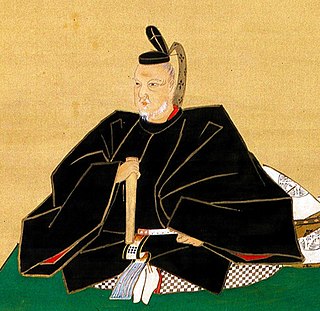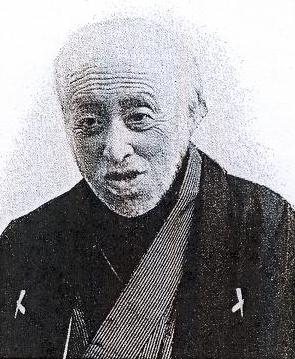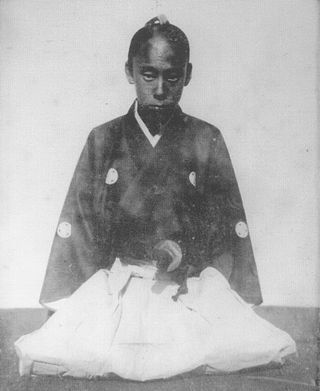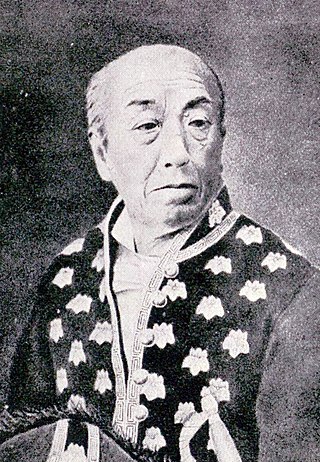
Matsudaira Katamori was a samurai who lived in Bakumatsu period and the early to mid Meiji period Japan. He was the 9th daimyō of the Aizu Domain and the Kyoto Shugoshoku. He initiated and established the Shinsengumi in 1863. During the Boshin War, he led Aizu Domain against the incipient Meiji government, but was severely defeated at the Battle of Aizu. Katamori's life was spared, and he later became the head kannushi of the Nikkō Tōshō-gū shrine. He, along with his three brothers Matsudaira Sadaaki, Tokugawa Yoshikatsu, and Tokugawa Mochiharu, had highly influential roles during the Meiji restoration and were called the "four Takasu brothers".

Baron Yamakawa Kenjirō was a Japanese samurai, politician, physicist, academic administrator, and author of several histories of the Boshin War. He served as president of Tokyo Imperial University, Kyushu Imperial University, and Kyoto Imperial University. He also served as a Privy Councilor and a member of the House of Peers. Though his name is commonly written "Yamakawa," he himself wrote it as "Yamagawa" in English.

Eugène Collache was a French Navy officer who fought in Japan for the shōgun during the Boshin War.

The Battle of Aizu was fought in northern Japan from October to November in autumn 1868, and was part of the Boshin War.

Aizuwakamatsu is a city in Fukushima Prefecture, Japan. As of 1 January 2021, the city had an estimated population of 118,159 in 50,365 households, and a population density of 310 persons per km2. The total area of the city was 382.97 square kilometres (147.87 sq mi).

Hoshina Masayuki was a Japanese daimyō of the early Edo period, who was the founder of what became the Matsudaira house of Aizu. He was an important figure in the politics and philosophy of the early Tokugawa shogunate.

The Battle of Hokuetsu took place during the Boshin War of the Meiji Restoration, which occurred in 1868 in the northwestern part of Japan, in the area of modern Niigata Prefecture.

Baron Yamakawa Hiroshi was a Bakumatsu period Aizu samurai who subsequently became a general in the early Meiji period Imperial Japanese Army, and a noted politician and educator. He was also one of the first persons to write a history of the Aizu War from the Aizu perspective. His brother-in-law was noted general Oyama Iwao, who married his sister Sutematsu.

Saigō Tanomo was a Japanese samurai of the late Edo period. Chief senior councilor of the Aizu clan, he achieved fame due to his distinguished action in the Boshin War. He adopted the name Hoshina Chikanori. Surviving the war, he became a Shinto priest, and achieved renown as a martial artist. He is considered one of the teachers of the famed Takeda Sōkaku.

Miharu Domain was a feudal domain under the Tokugawa shogunate of Edo period Japan. It was based at Miharu Castle in southern Mutsu Province in what is now part of modern-day Miharu, Fukushima. It was ruled for most of its history by the Akita clan.

Aizu Domain was a domain of the Tokugawa Shogunate of Japan during the Edo period from 1601 to 1871.
Hayashi Gonsuke was a Japanese samurai of the late Edo period. Also known by his formal name, Yasusada (安定), A retainer of the Aizu domain, Gonsuke was an accomplished martial artist of Ichinomiya ryu iaijutsu, Naganuma ryu strategy, and gunnery. Promoted to artillery magistrate in 1862, he went to Kyoto at the start of Lord Matsudaira Katamori's tenure as Kyoto Shugoshoku. Fighting at the various skirmishes in the 1860s, he most notably fought alongside Shinsengumi against Maki Izumi's force at Tennozan. Commanding Aizu artillery forces at the Battle of Toba–Fushimi, Gonsuke fought against overwhelming odds, coming under heavy fire while inadequately supported by spearmen instead of rifle infantry. Grabbing a long spear, he charged the enemy infantry but was shot repeatedly. Evacuated from the battlefield, he was placed on a Shogunate warship, and died at sea, en route to Edo. His age at death was 63.

Viscount Niwa Nagakuni was an Edo period Japanese samurai, and the 10th daimyō of Nihonmatsu Domain in the Tōhoku region of Japan. He was the 11th hereditary chieftain of the Niwa clan. His courtesy title was Saikyō-no-daifu, and his Court rank was Junior Fourth Rank, Lower Grade.

ViscountMatsudaira Nobunori was a Japanese samurai of the Bakumatsu period and the 10th daimyō of Aizu Domain.

Nakano Takeko was a Japanese female warrior of the Aizu Domain, who fought and died during the Boshin War. During the Battle of Aizu, she fought with a naginata and was the leader of an ad hoc corps of female combatants who fought in the battle independently.

The Niwa clan was a Japanese samurai clan of northern Honshū that claimed descent from Emperor Kanmu via Prince Yoshimine no Yasuo (785-80) and Kodama Koreyuki (d.1069).

Matsudaira Sadaaki was a Japanese daimyō of the Bakumatsu period, who was the last ruler of the Kuwana Domain. Sadaaki was the adopted heir of Matsudaira Sadamichi, the descendant of Sadatsuna, the third son of Hisamatsu Sadakatsu (1569–1623), who was Tokugawa Ieyasu's brother. His family was known as the Hisamatsu Matsudaira clan. It was to this family that Matsudaira Sadanobu also belonged.

Uesugi Narinori was the 12th daimyō of Yonezawa Domain in Dewa Province, Japan, under the Edo period Tokugawa shogunate of Japan.

The Wakamatsu Tea and Silk Farm Colony is believed to be the first permanent Japanese settlement in North America and the only settlement by samurai outside of Japan. The group was made up of 22 people from samurai families during the Boshin Civil War (1868–69) in Japan preceding the Meiji Restoration. The group purchased land from Charles Graner family in the Gold Hill region after coming to San Francisco in 1869. Though the group was able to successfully show their produce during the 1869 California State Agricultural Fair in Sacramento and the 1870 Horticultural Fair in San Francisco, the farm as a Japanese colony only existed between 1869 and 1871.

Matsudaira Sadanori was the 5th daimyō of Kuwana Domain in Ise Province in early Meiji period Japan.



















